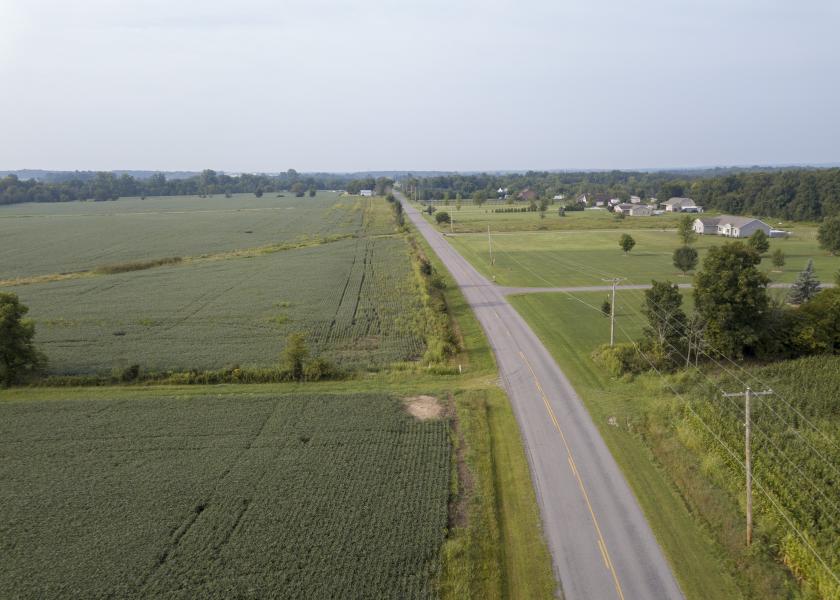Crop Tour Shows Dominating Yields in Ohio, South Dakota

Projected yields in Ohio and South Dakota from day one of the Pro Farmer Crop Tour topple recent history. Yields estimates jumped an impressive 9.1% in corn and 12.8% in soybeans for Ohio farmers compared to last year, and an astonishing 20.3% increase in corn and 13.9% increase in soybeans for South Dakota farmers.
“This is probably the best Ohio corn crop that I can remember in doing the tour,” says Brian Grete, Pro Farmer editor and leader of the eastern leg of the Crop Tour. “It was the ear count that really drove the numbers—almost 100 ears in 60 foot of row.”
The eastern leg wasn’t without its challenges, however. Gray leaf spot reared its ugly head in corn fields throughout Ohio.
“We did see some foliar stuff but it’s somewhat deceiving, too, because the crop is far enough along,” Grete says. “We saw a lot of dented corn and the crop is far enough along where the plant is starting to shut down anyway naturally. It’s probably going to hold on fairly well to what it has.”
Because the crop is more mature than typical, scouts anticipate this will be as close to real-world yields as you can get without running a combine through the fields.
“When you look at the Ohio bean crop it looks like a green carpet, lush, green and healthy,” Grete says. “It looks like it has not only the foliar factory going, but it also has the pod factory going and it has the moisture to finish.”
Ohio corn averaged 179.57 bu. per acre and soybeans hit 1,248.20 pods per 3X3 square. In 2017 the state estimates were 164.62 and 1,107.01 for corn and soybeans, respectively. 2018 estimates blow the three-year averages out of the water, too at 153.98 bu. per acre in corn and 1,095.77 pods in a 3X3 square in soybeans.
- District 1: 28 samples
- Corn: 176.93
- Soybeans: 1,319.32
- District 2: 10 corn, 11 soybean samples
- Corn: 167.63
- Soybeans: 1,089.99
- District 4: 44 corn, 43 soybean samples
- Corn: 179.63
- Soybeans: 1,291.93
- District 5: 24 samples
- Corn: 184.84
- Soybeans: 1,097.21
- District 7: 5 samples
- Corn: 191.17
- Soybeans: 1,546.69
The western leg of the tour didn’t disappoint when it came to high yields, either.
“What I noticed today was the ear length all day,” says Nick Ehlers, farmer and scout on the western leg of the tour. The average ear length this year was 7.16” compared to 6.79” last year and 6.74” three-year average.
“But the big difference was the ear counts,” says AgriTalk host Chip Flory. “It’s pretty remarkable: 93.22 ears in 60 foot of row. Last year was 84.35 and the three-year average is 84.82, so a big increase in the ears we’re finding out there.”
The estimates Pro Farmer scouts established today support what USDA predicted on Aug. 1, which put the crop at 170 bu. per acre. Pro Farmer actually sees that number going higher.
Soybeans did show some challenges today with several drowned-out spots. Disease pressure was dismal, with perhaps just a few isolated incidents. Overall though, soybeans look like they’ll meet or nearly meet USDA’s expectation to jump 14% compared to last year.
“They have a ways to go, but they have moisture to work with,” Ehlers says. “As long as they’ve got moisture to work with, they’re probably going to go ahead and finish okay.”
Despite a late start, South Dakota yields race to 178.01 bu. per acre in corn and 1,024.72 pods per 3X3 square in soybeans. In 2017 corn yields were only 147.97 bu. per acre, behind the three-year average of 154.56 bu. per are. Soybean estimates in 2017 hit 899.56, falling behind the three-year average of 975.05 pods per 3X3 square.
- District 5: 1 sample
- Corn: 177.19
- Soybeans: 648.00
- District 6: 23 samples
- Corn: 178.67
- Soybeans: 1,081.07
- District 9: 45 samples
- Corn: 177.70
- Soybeans: 1,004.29







